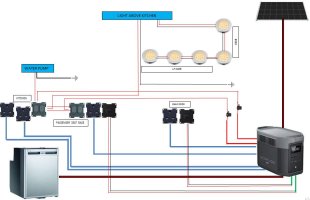Hey Guys,
Just to update you on the Ecoflow delta 2 Max that i set up in my T6 instead of a leisure battery system.
Everything works pretty good except for the diesel heater. The fridge lasts a good few days off grid and i have a cable run to the cigarette lighter so when i need to drive it tops it up ok.
I recently got the autoterm 2d installed and it doesn't work with it unfortunately. I didn't realise there would be such a high start up current with it, so there is a voltage drop to about 8/9 volts, and an undervoltage fault comes up on the diesal heater control panel and it shuts off.
The max output on the 12v supply on the ecoflow is 10amps and the diesel heater requires around 130-140 watts on start up for the first few minutes to heat up the glow plugs on it. So im short about 10-20 watts to get it going.
So now i need to install a leisure battery system anyway to power the diesel heater. If i was to do it all again I wouldnt bother with the ecoflow as I think its a bit restrictive.
For example If you want to power the lights of it, you would need to first switch on the unit and then the light switch, if you keep it on all the time it slowly uses up a small bit of power. Its ok if your off on a trip for a few days and you need it on anyway powering the fridge.
The other thing i noticed last month when i was testing the two 100w ecoflow solar panels i installed. With no power being drawn on the ecoflow i actually lost more power then gaining any. That being said there was hardly any sun out, i think the max i got off the 2 panels was about 30w for about 4 hours. So im not sure where it was using the power, maybe its checking to see if theres enough sun to take in the solar, not sure. If anyone has any ideas on this please let me know.
Now because i have the diesal heater pipe coming in under the driver seat im a bit restricted with the space under there to put in a battery next to the pipe. Does anyone know of a good battery to use that would fit in a space 33x18x19cm (LxWxH) as i need to try and fit it to the side of the pipe. And would anyone know of a good solution on a setup where i could have a leisure battery set up which could also charge the ecoflow unit.
I think the best thing i can do is have the fridge, diesal heater, lights etc running of the leisure battery, and use the ecoflow for powering the moniter that i will be installing for work. And also use the ecoflow as a backup to the fridge when going off grid. I just cant get my head around how im going to wire it up, any ideas would be a great help.
And if yas have any more questions about the ecoflow unit just let me know il be glad to help
Cheers!


